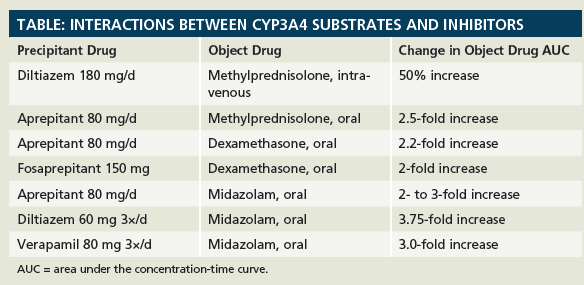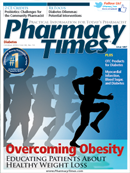Publication
Article
Pharmacy Times
Prediction of Potential Drug-Drug Interactions
We often get questions about potential drug—drug interactions (PDDIs) when there are few or no data evaluating a drug pair. These questions may refer to drugs that are new to the market and have not been widely studied, or to drugs that are quite mature, having been approved by the FDA before drug interaction studies were a common part of the approval process. Making reasonable predictions about PDDIs requires an understanding of the pharmacologic properties of drugs and the possible mechanisms of interaction.
Consider a patient stabilized on verapamil who is prescribed oral dexamethasone. What is the potential for verapamil to interact with dexamethasone? Corticosteroids include drugs that have been available for years and some relatively new therapeutic products. A search of the literature does not reveal any studies on an interaction between dexamethasone and verapamil. However, dexamethasone is a known substrate of CYP3A4 and P-glycoprotein (P-gp).1,2 In addition, verapamil is considered a moderate inhibitor of CYP3A4 and P-gp. Thus, one might expect an interaction in which verapamil inhibits elimination of dexamethasone. (For brevity, we will ignore the potential for CYP3A4 induction by dexamethasone.) The problem is that the magnitude of the PDDI between dexamethasone and verapamil is unknown.
Estimating the magnitude of a PDDI can often be based on the interaction between drugs with similar pharmacokinetic properties. The Table lists several interactions between CYP3A4 substrates and inhibitors that can offer some insight into a PDDI between verapamil and dexamethasone.

For example, while we found that there are no data on the effect of verapamil on dexamethasone elimination, an interaction between similar drugs—diltiazem and methylprednisolone— has been reported to result in a 50% increase in the area under the concentration- time curve (AUC) of methylprednisolone.3 While this study used intravenous methylprednisolone and thus avoided any effect of diltiazem on the absorption of methylprednisolone, the study does provide evidence for reduced systemic clearance of the corticosteroid by another moderate inhibitor of CYP3A4.
Several studies have reported the effect of aprepitant or fosaprepitant on methylprednisolone and dexamethasone.4-6 The magnitude of the effect of aprepitant on methylprednisolone and dexamethasone is comparable. Aprepitant produced a similar increase in the AUC of midazolam.6 Aprepitant, like verapamil, is considered a moderate CP3A4 inhibitor. Finally, a study comparing the effect of diltiazem and verapamil on midazolam found a similar increase in the AUC of midazolam.7 The similar increase in the AUC of midazolam with coadministration of aprepitant and verapamil likely reflects their comparable CYP3A4 inhibitory potency for the same substrate (midazolam).
Endnote
The above results indicate that verapamil would be expected to produce an increase in the AUC of dexamethasone of approximately the same magnitude as observed with aprepitant or diltiazem. The AUC of dexamethasone may increase by 50% to 200% during concurrent verapamil administration. It would be prudent to reduce the dose of dexamethasone in patients receiving verapamil and to monitor for signs of excessive steroid response.
Drs. Horn and Hansten are both professors of pharmacy at the University of Washington School of Pharmacy. For an electronic version of this article, including references, if any, visit www.hanstenandhorn.com.
References:
1. Gentile DM, Tomlinson ES, Maggs JL, Park BK, Back DJ. Dexamethasone metabolism by human liver in vitro. metabolite identification and inhibition of 6-hydroxylation. J Pharmacol Exp Ther. 1996;277:105-112.
2. Kovarik JM, Purba HS, Pongowski M, Gerbeau C, Humbert H, Mueller EA. Pharmacokinetics of dexamethasone and valspodar, a P-glycoprotein (mdr1) modulator: implications for coadministration. Pharmacotherapy. 1998;18:1230-1236.
3. Booker BM, Magee MH, Blum RA, Lates CD, Jusko WJ. Pharmacokinetic and pharmacodynamic interactions between diltiazem and methylprednisolone in healthy volunteers. Clin Pharmacol Ther. 2002;72:370-382.
4. McCrea JB, Majumdar AK, Goldberg MR, et al. Effects of the neurokinin1 receptor antagonist aprepitant on the pharmacokinetics of dexamethasone and methylprednisolone. Clin Pharmacol Ther. 2003;74:17-24.
5. Marbury TC, Ngo PL, Shadle CR, et al. Pharmacokinetics of oral dexamethasone and midazolam when administered with single-dose intravenous 150 mg fosaprepitant in healthy adult subjects. J Clin Pharmacol. 2011;51:1712-1720.
6. Emend [package insert]. Whitehouse Station, NJ: Merck & Co, Inc; 2006.
7. Backman JT, Olkkola KT, Aranko K, Himberg JJ, Neuvonen PJ. Dose of midazolam should be reduced during diltiazem and verapamil treatments. Br J Clin Pharmacol. 1994;37:221-225.







